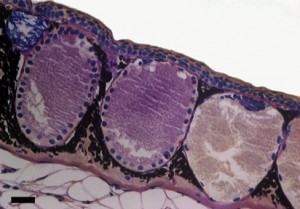Salamanders communicate via pheromones. My research focuses on understanding the structure, function, and evolution of pheromone-producing glands. Salamanders are known for their moist glandular skin, yet little is known about which glands actually produce pheromones other than the well-studied courtship glands on the male chin (known as the mental gland). While pheromones from the mental gland have been well studied, little is know about the pheromones that females produce or about the pheromones that males produce from non-mental glands sources. Interestingly, males of some species lack the pheromone-producing mental gland that is supposedly so important for courtship. Do they produce pheromones from other glands? Do they have pheromone genes?
Current projects
1) To identify pheromone producing glands in plethodontid salamanders we are starting a new project to first check the species’ genome for pheromone genes. Ideally we would like to be able to do this with formalin-fixed specimens, so we don’t have to use fresh tissue from living animals. Using primers for pheromone genes in Plethodon shermani, we will use the polymerase chain reaction (PCR) and gel electrophoresis to identify pheromone genes in other species. PCR products will be sequenced and compared to known pheromone genes. Sequence results from this study will be used to build specific probes for in-situ hybridization projects to identity specific pheromone-producing glands.
2) in situ hybridization studies: We design pheromone (PRF, PMF, SPF) specific mRNA probes to use with in situ hybridization to detect which glands, of the many in salamander skin, are actually producing pheromone mRNA in both males and females. Several questions can be addressed using this approach: 1) Where are courtship pheromones produced in males that lack specialized courtship glands? 2) Which glands in the post-cloacal region produce pheromones?

